1. Grollman JH Jr, Del Vicario M, Mittal AK. Percutaneous transluminal abdominal aortic angioplasty. AJR Am J Roentgenol. 1980; 134:1053–1054. PMID:
6768245.

2. Velasquez G, Castaneda-Zuniga W, Formanek A, Zollikofer C, Barreto A, Nicoloff D, et al. Nonsurgical aortoplasty in Leriche syndrome. Radiology. 1980; 134:359–360. PMID:
7352213.

3. Tegtmeyer CJ, Wellons HA, Thompson RN. Balloon dilation of the abdominal aorta. JAMA. 1980; 244:2636–2637. PMID:
7431611.

4. Becker GJ. Intravascular stents. General principles and status of lower-extremity arterial applications. Circulation. 1991; 83:I122–I136. PMID:
1991395.
5. Hallisey MJ, Parker BC, van Breda A. Current status and extended applications of intravascular stents. Curr Opin Radiol. 1992; 4:7–12. PMID:
1627454.
6. Johnston KW, Rae M, Hogg-Johnston SA, Colapinto RF, Walker PM, Baird RJ, et al. Five-year results of a prospective study of percutaneous transluminal angioplasty. Ann Surg. 1987; 206:403–413. PMID:
2959214.
7. Becker GJ, Katzen BT, Dake MD. Noncoronary angioplasty. Radiology. 1989; 170:921–940. PMID:
2521745.

8. Gunther RW, Vorwerk D, Bohndorf K, Peters I, el-Din A, Messmer B, et al. Iliac and femoral artery stenoses and occlusions: treatment with intravascular stents. Radiology. 1989; 172:725–730. PMID:
2528159.

9. Rees CR, Palmaz JC, Garcia O, Roeren T, Richter GM, Gardiner G Jr, et al. Angioplasty and stenting of completely occluded iliac arteries. Radiology. 1989; 172:953–959. PMID:
2528170.

10. Long AL, Page PE, Raynaud AC, Beyssen BM, Fiessinger JN, Ducimetière P, et al. Percutaneous iliac artery stent: angiographic long-term follow-up. Radiology. 1991; 180:771–778. PMID:
1831274.

11. Vorwerk D, Gunther RW. Mechanical revascularization of occluded iliac arteries with use of self-expandable endoprostheses. Radiology. 1990; 175:411–415. PMID:
2139231.

12. Schurmann K, Mahnken A, Meyer J, Haage P, Chalabi K, Peters I, et al. Long-term results 10 years after iliac arterial stent placement. Radiology. 2002; 224:731–738. PMID:
12202707.

13. Vorwerk D, Gunther R, Schurmann K, Wendt G. Primary stent placement for chronic iliac artery occlusions: follow-up results in 103 patients. Radiology. 1995; 194:745–749. PMID:
7862973.

14. Nawaz S, Cleveland T, Gaines P, Beard J, Chan P. Aortoiliac stenting, determinants of clinical outcome. Eur J Vasc Endovasc Surg. 1999; 17:351–359. PMID:
10204060.

15. Sacks D, Marinelli C, Martin L, Spies J. Reporting standards for clinical evaluation of new peripheral arterial revascularization devices. J Vasc Interv Radiol. 2003; 14:S395–S404. PMID:
14514855.

16. Littooy FN, Steffan G, Steinam S, Saletta C, Greisler HP. An 11-year experience with aortofemoral bypass grafting. Cardiovasc Surg. 1993; 1:232–238. PMID:
8076036.
17. Schneider JR, Besso SR, Walsh DB, Zwolak RM, Cronenwett JL. Femorofemoral versus aortobifemoral bypass: outcome and hemodynamic results. J Vasc Surg. 1994; 19:43–55. PMID:
8301737.

18. Huber TS, Harward TR, Flynn TC, Albright JL, Seeger JM. Operative mortality rates after elective infrarenal aortic reconstructions. J Vasc Surg. 1995; 22:287–293. PMID:
7674472.

19. Erdoes LS, Bernhard VM, Berman SS. Aortofemoral graft occlusion: strategy and timing of reoperation. Cardiovasc Surg. 1995; 3:277–283. PMID:
7655841.

20. Passman MA, Taylor LM, Moneta GL, Edward JM, Yeager RA, McConnell DB, et al. Comparison of axillofemoral and aortofemoral bypass for aortoiliac occlusive disease. J Vasc Surg. 1996; 23:263–271. PMID:
8637103.
21. Gunther RW, Vorwerk D, Antonucci F, Beyssen B, Essinger A, Gaux JC, et al. Iliac artery stenosis or obstruction after unsuccessful balloon angioplasty: treatment with a self-expandable stent. AJR Am J Roentgenol. 1991; 156:389–393. PMID:
1824733.
22. Hallisey MJ, Parker BC, van Breda A. Current status and extended applications of intravascular stents. Curr Opin Radiol. 1992; 4:7–12. PMID:
1627454.
23. Bonn J, Gardiner GA Jr, Shapiro MJ, Sullivan KL, Levin DC. Palmaz vascular stent: initial clinical experience. Radiology. 1990; 174:741–745. PMID:
2137633.

24. Liermann D, Strecker EP, Peters J. The Strecker stent: indications and results in iliac and femoropopliteal arteries. Cardiovasc Intervent Radiol. 1992; 15:298–305. PMID:
1423390.

25. Szilagyi DE, Elliott JP Jr, Smith RF, Reddy DJ, McPharlin M. A thirty-year survey of the reconstructive surgical treatment of aortoiliac occlusive disease. J Vasc Surg. 1986; 3:421–436. PMID:
3951027.

26. Nevelsteen A, Wouters L, Suy R. Aortofemoral dacron reconstruction for aorto-iliac occlusive disease: a 25-year survey. Eur J Vasc Surg. 1991; 5:179–186. PMID:
1828041.

27. Richter GM, Roeren T, Noeldge G, Landwehr P, Allenberg JR, Kauffmann GW, et al. Initial long-term results of a randomized 5-year study: iliac stent implantation versus PTA. Vasa Suppl. 1992; 35:192–193. PMID:
1481044.
28. Vorwerk D, Gunther RW, Schurmann K, Wendt G. Aortic and iliac stenoses: follow-up results of stent placement after insufficient balloon angioplasty in 118 cases. Radiology. 1996; 198:45–48. PMID:
8539403.

29. Cikrit DF, Gustafson PA, Dalsing MC, Harris VJ, Lalka SG, Sawchuk AP, et al. Long-term follow-up of the Palmaz stent for iliac occlusive disease. Surgery. 1995; 118:608–614. PMID:
7570312.

30. Palmaz JC, Laborde JC, Rivera FJ, Encarnacion CE, Lutz JD, Moss JG. Stenting of the iliac arteries with the Palmaz stent: experience from a multicenter trial. Cardiovasc Intervent Radiol. 1992; 15:291–297. PMID:
1423389.

31. De Vries SO, Hunink MG. Results of aortic bifurcation grafts for aortoiliac occlusive disease: a meta-analysis. J Vasc Surg. 1997; 26:558–569. PMID:
9357455.

32. Lee ES, Steenson CC, Trimble KE, Caldwell MP, Kuskowski MA, Santilli SM. Comparing patency rates between external iliac and common iliac artery stents. J Vasc Surg. 2000; 31:889–894. PMID:
10805878.

33. Johnston KW. Iliac arteries: reanalysis of results of balloon angioplasty. Radiology. 1993; 186:207–212. PMID:
8416566.

34. Sullivan TM, Childs MB, Bacharach JM, Gray BH, Piedmonte MR. Percutaneous trasluminal angioplasty and primary stenting of the iliac arteries in 288 patients. J Vasc Surg. 1997; 25:29–38. discussion 38-9. PMID:
9013905.
35. Timaran CH, Stevens SL, Freeman MB, Goldman MH. Predictors for adverse outcome after iliac angioplasty and stenting for limb-threatening ischemia. J Vasc Surg. 2002; 36:507–513. PMID:
12218974.

36. Murphy TP, Webb MS, Lambiase RE, Haas RA, Dorfman GS, Carney WI Jr, et al. Percutaneous revascularization of complex iliac artery stenoses and occlusions with use of Wallstents: three-year experience. J Vasc Interv Radiol. 1996; 7:21–27. PMID:
8773970.

37. Dyet JF, Gaines PA, Nicholson AA, Cleveland T, Cook AM, Wilkinson AR, et al. Treatment of chronic iliac artery occlusions by means of percutaneous endovascular stent placement. J Vasc Interv Radiol. 1997; 8:349–353. PMID:
9152906.

38. Long AL, Sapoval MR, Beyssen BM, Auguste MC, Le Bras Y, Raynaud AC, et al. Strecker stent implantation in iliac arteries: patency and predictive factors for long-term success. Radiology. 1995; 194:739–744. PMID:
7862972.

39. Blum U, Gabelmann A, Redecker M, Noldge G, Dornberg W, Grosser G, et al. Percutaneous recanalization of iliac artery occlusions: results of a prospective study. Radiology. 1993; 189:536–540. PMID:
8210387.

40. Pentecost MJ, Criqui MH, Dorros G, Goldstone J, Johnston KW, Martin EC, et al. Guidelines for peripheral percutaneous transluminal angioplasty of the abdominal aorta and lower extremity vessels. A statement for health professionals from a special writing group of the Councils on Cardiovascular Radiology, Arteriosclerosis, Cardio-Thoracic and Vascular Surgery, Clinical Cardiology, and Epidemiology and Prevention, the American Heart Association. Circulation. 1994; 89:511–531. PMID:
8281692.

41. Timaran CH, Stevens SL, Freeman MB, Goldman MH. External iliac and common iliac artery angioplasty and stenting in men and women. J Vasc Surg. 2001; 34:440–446. PMID:
11533595.

42. Darcy MD, Vedantham S, Kaufman JA. Peripheral vascular interventions. 2001. 2nd ed. SCVIR;p. 53–70.
43. Darcy MD, Vedantham S, Kaufman JA. Peripheral vascular interventions. 2001. 2nd ed. SCVIR;p. 205–220.
44. Uberoi R, Sarker B, Coleman J, Mudawi A, Ashour H. Duplex follow-up of aorto-iliac stents. Eur J Vasc Endovasc Surg. 2002; 23:331–335. PMID:
11991695.

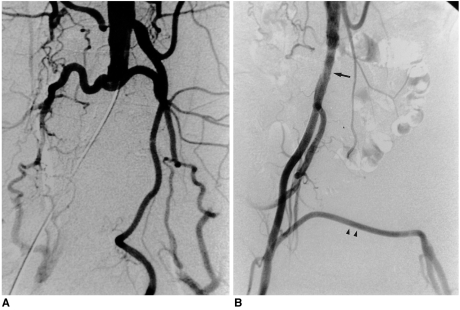
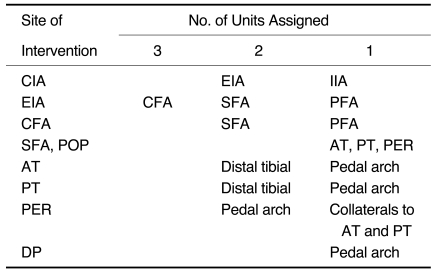
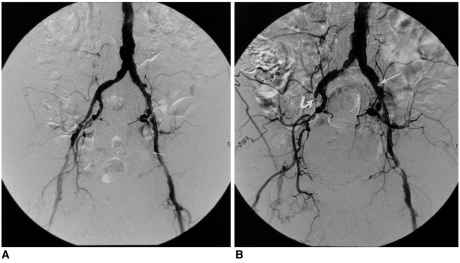




 PDF
PDF ePub
ePub Citation
Citation Print
Print


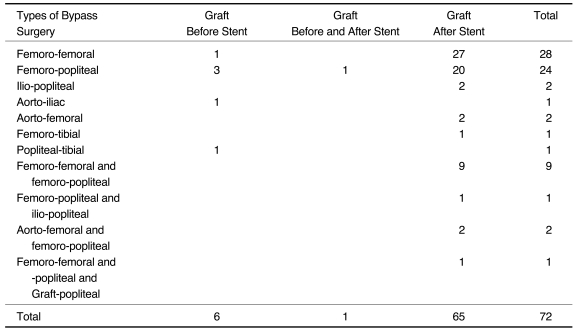
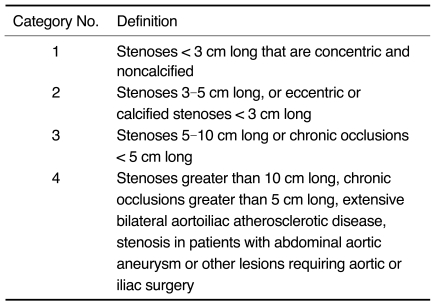
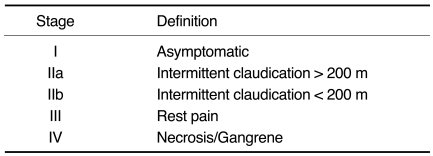

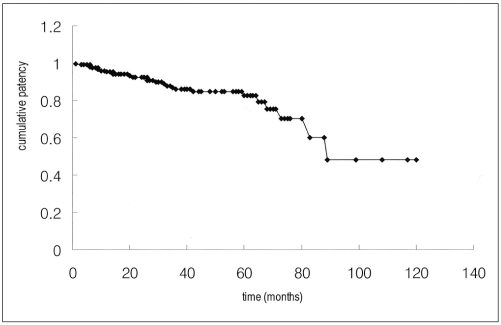
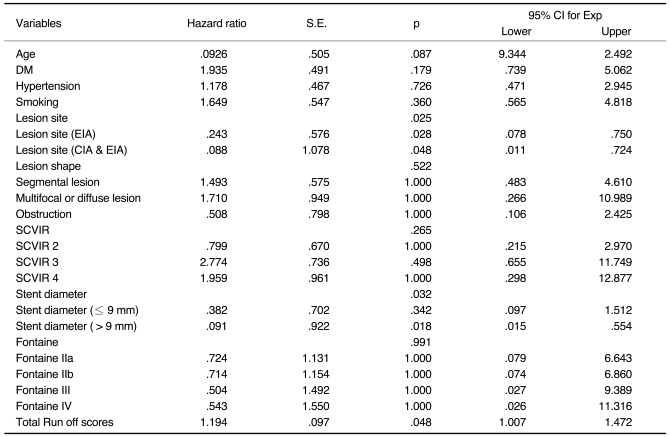
 XML Download
XML Download